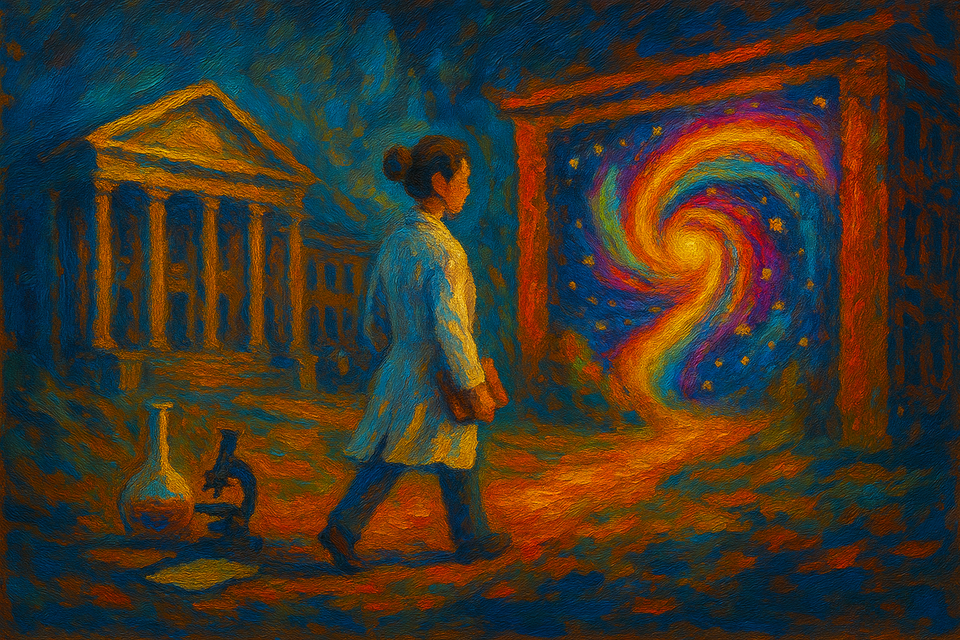We Never Cross The Buildings: Why is it so hard to start a collaboration in academia?

Altynai holds a Master's degree in Data Science from the University of Manchester. Her background spans data journalism to data art, and in her work, she transforms textual data into impactful solutions through research publications. With her interdisciplinary experience in storytelling and art, she bridges the gap between technical expertise and social impact. Currently, she is building PeerMatch, a collaboration tool for scientists at all levels.
A newly arrived PhD student walks into a lab full of postdocs and fellow students. The head professor is charismatic, motivated by breakthrough publications, and the group is renowned for its focus on a narrow slice of biotechnology. Everyone shares the same disciplinary training and even the same first language. That homogeneity makes the student feel like an outsider. It shouldn't be unusual, but many labs still resemble monocultures.
Is interdisciplinary collaboration even possible when everyone around you studied the same subject?
This is not just me pondering this question. Many studies have examined how collaboration emerges, why and when. In Michigan, scientists found that collaboration is most likely to happen between research teams that are in the same building, and being on the same floor doubles the chances. Another study examining 100 of the world's most prominent scientists across eight fields identified four early‑career factors linked to lasting impact: working at a top‑25 university, publishing in highly ranked journals, consistently publishing in top‑quartile journals, and co‑authoring with other prominent researchers (Krauss et al., 2023). Over 95% of the scientists had at least one of these features in their first five years, and the advantage persists 10, 15, and even 20 years later. In other words, early access to strong networks and high‑impact collaborators makes a lasting difference. A graduate student who cannot even meet the lab next door is unlikely to co‑author with a high‑impact mentor.
Why Diversity Matters
Interdisciplinary teams do more than make researchers feel less isolated; they make science better. A review on interdisciplinary research teams notes that incorporating conceptual and methodological strategies from a variety of disciplines yields transformative results (Brown et al., 2023). Empirical data show that teams with diverse backgrounds are more productive: researchers who analysed 1,415 experiments at the National High Magnetic Field Laboratory found that interdisciplinary diversity was associated with higher research productivity, measured by the volume of publications. Diversity of expertise, experiences, and even personality traits enriches problem‑solving and resilience.
So how do we close the gap between departments? Insights from early‑career researcher networks show that supportive collegial relationships, institutional support, job security, and funding are critical facilitators, while time management challenges, limited resources, and lack of contacts are major barriers. International collaborations not only provide professional support but also increase opportunities for networking, problem‑solving, and publishing (Carroll et al., 2010).
However, in today's academia, the culture still rewards individual achievement over cooperation. The metrics that shape hiring and funding decisions favour researchers who already have an early‑career advantage (Krauss et al., 2023). Those metrics often discourage interdisciplinary work because contributions are harder to quantify and credit. If we want science to advance "together" and "across disciplines," we need radical openness, starting with structures and incentives that value collaboration as much as individual brilliance.
Universities could start by incentivising cross‑departmental seed grants and even "bringing" disciplines closer to each other by relocating entire research teams, adopting policies that recognise team science in promotion criteria, and hosting regular interdisciplinary mixers. This cross-discipline collaboration encouragement has already been written into future strategies and indicated as criteria at some universities. But for early‑career scientists seeking collaborations, especially cross-disciplinary ones, it still remains a question dependent on seniors, conference setups, and formal programmes and networks.
Breaking the silos is not just about kindness; it is an evidence‑based strategy for producing more influential, more equitable science. The student in the vignette will only feel at home when academic institutions embrace the fact that the most impactful discoveries come from conversations across the hall and across disciplines. And yes, the collaboration chemistry is something we cannot predict, but if we never cross that building, we will also be removing the mere chances.
References
Brown, S.-A., Sparapani, R., Osinski, K., Zhang, J., Blessing, J., Cheng, F. & others (2023) Team principles for successful interdisciplinary research teams. American Heart Journal Plus: Cardiology Research and Practice, 32, 100306. Available at: https://pmc.ncbi.nlm.nih.gov/articles/PMC10946054/
University of Michigan. (2012, October 25). Sharing space: Proximity breeds collaboration. ScienceDaily. Retrieved October 20, 2025 from www.sciencedaily.com/releases/2012/10/121025174631.htm
Carroll, J.K., Albada, A., Farahani, M.A., Lithner, M. & others (2010) ‘Enhancing international collaboration among early career researchers’, Patient Education and Counseling, 80(3), pp. 417–420. Available at: https://www.researchgate.net/publication/45388596_Enhancing_international_collaboration_among_early_career_researchers
Krauss, A., Danús, L. & Sales-Pardo, M. (2023) ‘Early-career factors largely determine the future impact of prominent researchers: evidence across eight scientific fields’, Scientific Reports, 13, 18794. Available at: https://pmc.ncbi.nlm.nih.gov/articles/PMC10620415/

Comments ()